Table of Contents

Key takeaways:
- MRR growth tracks the increases and decreases in monthly recurring revenue
- While MRR isn’t always linear—with factors like expansions, contractions, and cancellations impacting revenue—, it is important to monitor consistently
- Improving MRR growth rate is multi-faceted, and may involve reducing churn, upselling for expansions, and improving customer retention
- Tools like Baremetrics help subscription companies better understand key MRR metrics and what’s driving them
Contrary to what you might see in some case studies, MRR growth is not always linear.
Through working with various SaaS companies, talking to founders and even looking at our journey here at Baremetrics, I’ve seen firsthand how startups can experience periods of flat or even negative growth.
And when it happens, so many companies default to “how do we get more customers?”
There’s a common misconception that the only way to improve MRR growth is by getting more customers. Not only is this untrue, but that mindset can dig you into a hole that’s hard to get out of. I’ll explain why later.
Don’t get me wrong. Getting more users to pay you is a good thing. But MRR growth is about more than just getting new customers.
In this article, I’ll explain MRR growth, calculate it, and improve it without relying solely on new customers.
How to Calculate MRR Growth
I know many of you will probably skip right past this part, but stick with me for a second.
You need to understand how to calculate the metric to improve your MRR growth rate.
MRR growth is the change in your MRR over a period of time.
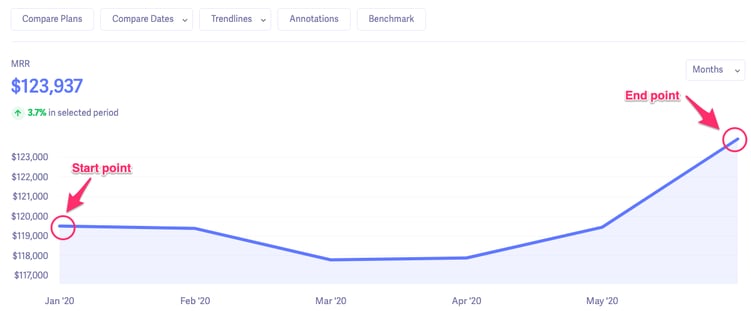
The start and end numbers are helpful, but what a lot of companies (and investors) want to see is your MRR growth rate.
MRR growth rate is your MRR growth expressed as a percentage.
Here’s the formula to calculate your monthly MRR growth rate:
[(Second Month Revenue) – (First Month Revenue)] / (First Month Revenue)
And here’s what an MRR growth rate chart looks like in Baremetrics. You’ll notice it pretty much mirrors the screenshot of our actual MRR above.
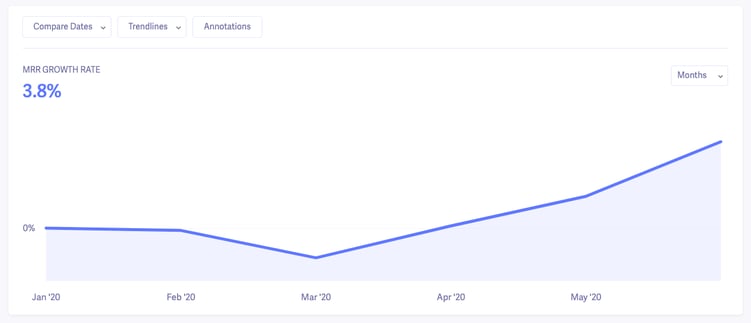
You can check out our blog posts to see how to see other MRR calculations and MRR calculation mistakes to avoid.
Why MRR Growth Rate Matters
Your MRR growth rate is important because it shows how much you’re growing (or not growing) over time. If your growth rate is slow or even declining for an extended period of time, it could be a red flag.
And according to Tim Schumacher, founder of SaaS.group, MRR growth plays an important role in your company’s valuation if you plan on selling.
"From an Angel or VC investor point of view, slow or no MRR growth is definitely a red flag, since all investors look for high-growth companies. For a strategic or financial buyer, it’s a different story. Of course, MRR growth is always better than slow or no growth, but at the end of the day, it merely affects the multiple which is paid for a company. For a high-growth company (5%+ monthly growth), a seller might be able to get twice the revenue (or profit) multiple compared to the same company which is flat."
- Tim Schumacher, Founder @ SaaS.Group
Here’s the thing. Your MRR growth rate is just an output.
To improve it, you need to focus on the inputs (i.e., the numbers that go into calculating your MRR growth).
As you saw, the formula for calculating your MRR growth is pretty simple on the surface. You just need to know your starting MRR and your ending MRR. But in order to take action on the number, you need to focus on the period in between.
Here’s a graphic to illustrate what I’m talking about.
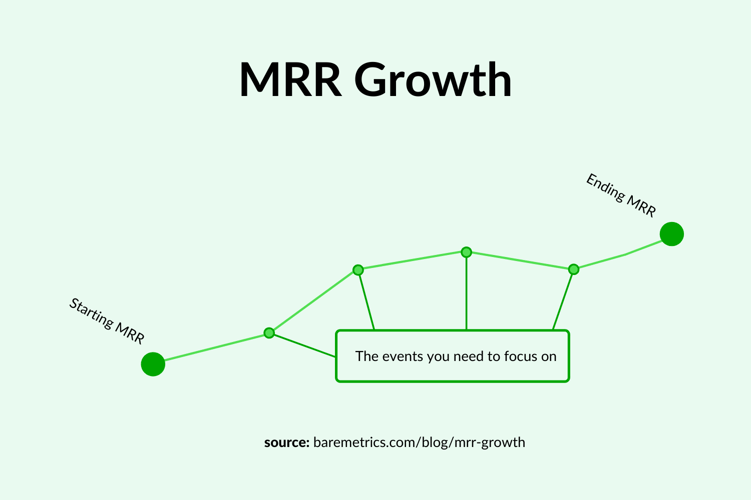
All the points on the graph are events that caused your MRR to go up or down. Those are the “inputs” that determine your MRR growth rate. They include things like:
- Churn
- New customers
- Expansion revenue
- Pricing changes you might’ve made
- Seasonality
You directly impact your company’s MRR growth by manipulating these different inputs.
For example, if you see a drop in your MRR growth, churn could be outpacing new customer acquisition. If you’re flat, it could indicate that your product isn’t priced for growth. There are a number of possibilities.
Our goal is to optimize all these different inputs to see a positive impact on the output (MRR growth). But just getting more customers isn’t always the answer.
Why Customer Acquisition Isn’t Always The Key To MRR Growth
As I mentioned in the intro, when you see your MRR growth stall or decline, it’s natural to assume you just need more customers.
While that can help, I suggest putting just as much (if not more) effort into the other inputs.
It Can Get Expensive
If you’ve ever worked for a SaaS company that was primarily focused on customer acquisition as a growth strategy, I’m sure you’ve seen how expensive it can get.
The “get new customers at all costs” approach is particularly popular with highly funded companies. When you have millions of dollars to spend, throwing it at ads and other marketing channels is super tempting to get more users.
But if the rest of your customer journey is lacking, you could waste much money.
Until you’ve built a solid retention strategy that reduces churn and improves LTV, it doesn’t make much sense to focus on getting more people in the door, assuming you’re not a new company that just needs users, of course.

It Limits You
Another issue with focusing primarily on customer acquisition, is it limits your potential MRR growth. I’ll dive into the specifics in the next section, but one of the keys behind our MRR growth at Baremetrics was our focus on expansion revenue.
By creating add-on products like Cancellation Insights, Messaging, and Recover, we were able to:
- Upsell our existing customers (which also improves LTV)
- Reach a new pool of people who might not have bought our flagship product but are interested in our other products
When all you’re thinking about is, “How can I get new customers?” you completely miss out on other opportunities that can dramatically improve your MRR growth.
Acquiring New Customers Might Not Be The Problem
Lastly, sometimes, the reason you can’t grow just doesn’t have anything to do with your ability to acquire new customers.
Even if your number of active customers grows each month, that doesn’t mean your MRR growth rate is too.
You could be experiencing massive MRR churn if your new customers are paying less than the people who churned. Your average revenue per user might be too low. You could be experiencing a lot of contraction from people downgrading their accounts.
The point is that you should never assume your MRR growth isn’t trending upwards because you’re not getting enough new customers.
Now that we’ve established that, let’s talk about some other ways to improve your MRR growth rate besides getting new customers.
3 Ways To Improve Your MRR Growth (Besides Getting More Customers)
Now that you know the what and why, let’s discuss the “how”. Just knowing your MRR growth rate is fine. But ultimately, your goal should be to improve it.
Like most things in business, data can be your best friend here. Let’s take a look at some practical ways to boost your MRR growth.
1. Reduce Churn
Churn MRR can have a serious impact on MRR growth even when you’ve got New MRR from active client acquisitions.
If you can’t control your churn, acquiring new customers isn’t going to fix your MRR growth problems. It’s like trying to work out to compensate for your poor diet. You might get some short-term results, but eventually, you’re going to plateau.
When you have a balance of low churn plus an effective customer acquisition strategy, you’re in a position for real growth. Let’s talk about how to start chipping away at your churn.
Obviously, you want to decrease your churn overall. But that’s a big mountain to climb.
Instead, let’s break it down into a series of “hills”. That way, you’ll be able to get some smaller wins on your way up the mountain.
First, we’ll need to identify where most of your churn comes from. That means tracking the cancellation reasons that are costing you the most money.
You can do that with a tool like Cancellation Insights, which sends a cancellation survey to every user when they cancel their account.

Once you start gathering responses, you’ll be able to see exactly which cancellation reasons result in the most MRR loss.
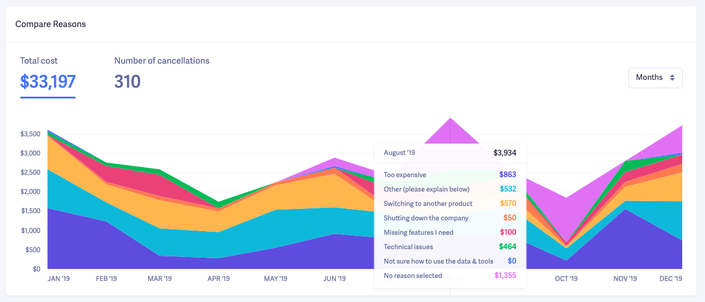
Now, instead of asking “how do we decrease churn?” you have specific action items you can build a plan around.
Whether it’s the lack of a specific feature, bad onboarding or whatever the main cause, you know exactly why people are churning and can work towards fixing it.
Even if your customer acquisition stays flat (meaning you’re acquiring the same number of customers each month), if you can decrease your monthly churn you’ll see an improvement in your MRR growth because you’re losing less MRR.
Here’s an example of this in action from our own company.
You can see here that as our churn rate has gone down over the past six months, our MRR growth has increased.
While some of the improvements in our MRR growth rate are due to an increase in expansion revenue (from our add-on products), decreasing churn plays a major role.
Our churn over the past six months
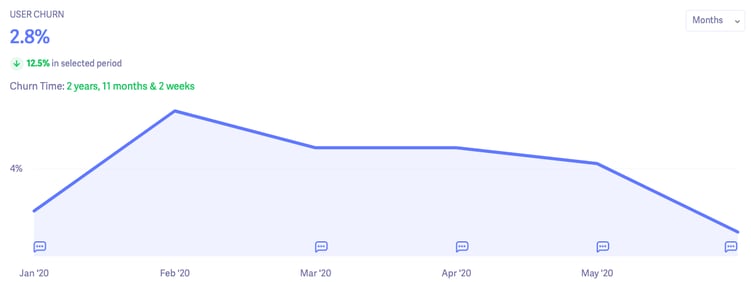
Our MRR growth rate over the past six months
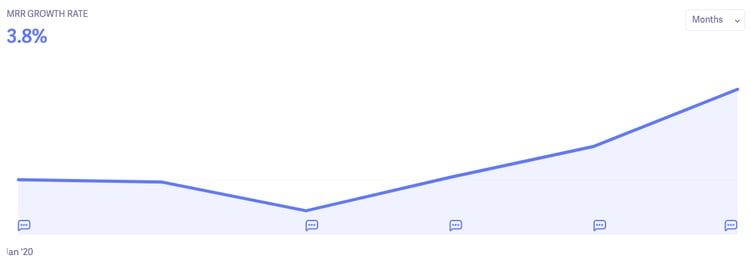
The main point I’m trying to illustrate is that “more customers” isn’t the only (or best) way to improve your MRR growth rate.
If you can lose fewer customers each month while keeping your acquisition and expansion revenue at least steady, you can still see growth. If you want more ideas on how to reduce churn, check out these articles:
- 5 Ways to Prevent Involuntary Churn in SaaS
- 6 Proven Strategies to Reduce Churn (With Real Examples)
- A 3-Step Guide to Analyzing Your Churn
- How to Use Cohort Analysis to Reduce Churn & Improve Retention
- 3 Customer Retention Metrics to Measure for Growth
- How to Write Effective Dunning Emails (30+ Examples Included)
2. Prioritize Expansion Revenue
Sometimes, increasing revenue doesn’t mean getting new customers. Why not sell to existing customers who already use and like your product?
Expansion revenue is revenue you get from existing customers through:
- Add-ons: Additional add-on products outside of your customer’s subscription (like Cancellation Insights and Recover 😉)
- Upsells: Upgrading to a higher-priced plan
- Cross-selling: Revenue from additional products to give customers a more complete solution (ex. Product training, setup fee)
According to data from KeyBanc, in 2018, the average SaaS company generated 37% of gross new ARR bookings from expansions and upsells (for companies with $5M+ in ARR).
And the companies in the $15M+ ARR club tend to do even more.

An added benefit of expansion revenue is it costs less to upsell and expand your existing customers than to acquire new ones.
Think about it. You’re essentially selling to people who’ve already shown they’re willing to buy from you versus trying to convince new people that your product is worth paying for.
Expansion revenue has also been a big part of our growth here at Baremetrics. Here’s a look at MRR from our current active customers using two of our add-on products.

And if you take a look at our MRR over the past six months, you’ll notice that our expansion revenue is greater than our MRR from new customers most months.

Expansion revenue is also key to MRR growth for companies that charge per-user. For example, take a look at Hubstaff.
Their monthly pricing plans are pretty low (most users are on their Basic or Premium plans).

But take a look at where their MRR comes from. A good chunk of it is expansion revenue from upgrades and additional users.

For comparison, look at a company like Proofhub. They charge a flat rate for unlimited users.
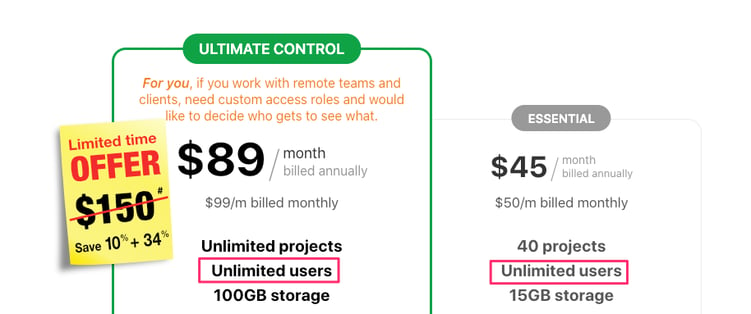
For them to get positive MRR growth, they’re almost completely dependent on how many new customers they can acquire each month, minus churn and contractions.
That’s a more challenging situation for growth.
Expansion revenue is another lever you can use to improve your MRR growth. Whether it’s through upgrades, charging per user, or additional products, think of ways you can expand beyond your current plans and offerings.
Don’t forget to track contraction MRR, too; it can decrease your MRR growth rate and committed MRR metrics.
3. Experiment With Your Pricing
Pricing your SaaS product is one of the biggest struggles startups run into.
Are you charging too much? Not enough? What happens if you raise your prices and customers start to churn?
I won’t dive into the specifics of how to price your product in this article, because our Head of Growth already wrote a super in-depth guide to SaaS pricing here. But here’s a good way to experiment with your pricing and improve your MRR growth.
Use your data!
Some companies like to use surveys using Van Westendorp’s Price Sensitivity Meter to determine how much users would be willing to pay. But if you already have paying customers, why not use that data instead?
Start by identifying which pricing plans have the lowest churn rates. If you have Baremetrics, you can find this data under Metrics > User Churn. Sort the table by churn rate.

Lower churn (and longer time to churn) is an indicator that users under these price plans are getting enough value from your product to justify keeping it long-term. But it could also mean that you’re priced too low.
You can experiment with the plans with low churn and a long time to churn first.
Slightly increase the pricing on one of these plans (for new customers only) and monitor:
- Signups: Are more or fewer people signing up for this plan now that the price is higher?
- Churn: Are customers who’ve signed up with this higher price plan churning at a higher rate than the original priced plan?
If the number of signups you’re getting each month stays consistent, it means people aren’t being put off by your slightly higher pricing. And if your churn rate stays relatively unchanged, then your value:price ratio is in a good spot.
Even if you keep all your current customer’s pricing unchanged, you’ll be able to boost your MRR growth going forward if your changes work.
Keep An Eye On Your MRR Growth Rate
Your MRR growth rate is a vital SaaS metric that indicates the health of your business over time, and that goes both for your MRR and Net MRR growth rates.
You don’t have to obsess over the number daily. Check it month to month to see how you’re trending. Then, use the insights to create action items for the next few months.
You could focus on churn for one quarter, then do some pricing experiments another quarter. But at least you’ll have a plan. And since you have metrics in place, it’s easy to measure what works and what doesn’t.
Don’t forget that your MRR will be different from accounting revenue. It’s important to track all key metrics and your bottom line to better understand your business’s profitability. Baremetrics can help with that, offering insight into 26 key performance and financial metrics so you can make better, strategic decisions for your company.
Tired of wasting time on spreadsheets? Get a free trial of Baremetrics today!




